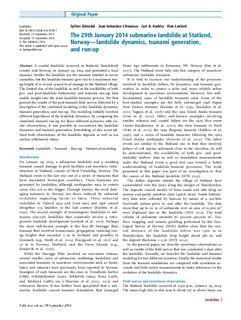| dc.contributor.author | Glimsdal, Sylfest | |
| dc.contributor.author | L'Heureux, Jean-Sébastien | |
| dc.contributor.author | Harbitz, Carl Bonnevie | |
| dc.contributor.author | Løvholt, Finn | |
| dc.date.accessioned | 2016-09-28T07:15:58Z | |
| dc.date.accessioned | 2016-09-29T09:11:50Z | |
| dc.date.available | 2016-09-28T07:15:58Z | |
| dc.date.available | 2016-09-29T09:11:50Z | |
| dc.date.issued | 2016 | |
| dc.identifier.citation | Landslides : Journal of the International Consortium on Landslides 2016 | |
| dc.identifier.issn | 1612-510X | |
| dc.identifier.uri | http://hdl.handle.net/11250/2411692 | |
| dc.description | - | |
| dc.description.abstract | A coastal landslide occurred at Statland, Namdalseid county, mid-Norway, on January 29, 2014, and generated a local tsunami. Neither the landslide nor the tsunami resulted in severe casualties, but the landslide tsunami gave rise to a maximum run-up height of 10 m and caused local damage to the Statland village. The limited size of the landslide as well as the availability of both pre- and post-landslide bathymetry and tsunami run-up data enable insight into the joint landslide-tsunami process. We first present the results of the post-tsunami field survey, followed by a description of the combined modeling of the landslide dynamics, tsunami generation, and run-up. The modeling initially involved different hypotheses of the landslide dynamics. By comparing the simulated tsunami run-up for these different scenarios with on-site observations, it was possible to reconstruct the landslide dynamics and tsunami generation. Retrofitting of this event utilized both observations of the landslide deposits as well as sea surface withdrawal values. | |
| dc.language.iso | eng | |
| dc.title | The 29th January 2014 submarine landslide at Statland, Norway—landslide dynamics, tsunami generation, and run-up | |
| dc.type | Journal article | |
| dc.date.updated | 2016-09-28T07:15:58Z | |
| dc.identifier.doi | 10.1007/s10346-016-0758-7 | |
| dc.identifier.cristin | 1386670 | |
| dc.relation.project | Norges forskningsråd: 231252 | |
